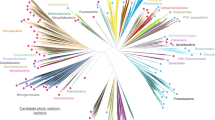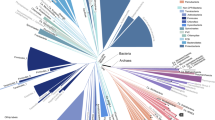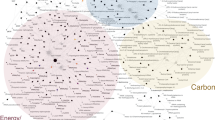Abstract
The division and cell wall (dcw) gene cluster in Bacteria comprises 17 genes encoding key steps in peptidoglycan synthesis and cytokinesis. To understand the origin and evolution of this cluster, we analysed its presence in over 1,000 bacterial genomes. We show that the dcw gene cluster is strikingly conserved in both gene content and gene order across all Bacteria and has undergone only a few rearrangements in some phyla, potentially linked to cell envelope specificities, but not directly to cell shape. A large concatenation of the 12 most conserved dcw cluster genes produced a robust tree of Bacteria that is largely consistent with recent phylogenies based on frequently used markers. Moreover, evolutionary divergence analyses show that the dcw gene cluster offers advantages in defining high-rank taxonomic boundaries and indicate at least two main phyla in the Candidate Phyla Radiation (CPR) matching a sharp dichotomy in dcw gene cluster arrangement. Our results place the origin of the dcw gene cluster in the Last Bacterial Common Ancestor and show that it has evolved vertically for billions of years, similar to major cellular machineries such as the ribosome. The strong phylogenetic signal, combined with conserved genomic synteny at large evolutionary distances, makes the dcw gene cluster a robust alternative set of markers to resolve the ever-growing tree of Bacteria.
This is a preview of subscription content, access via your institution
Access options
Access Nature and 54 other Nature Portfolio journals
Get Nature+, our best-value online-access subscription
$29.99 / 30 days
cancel any time
Subscribe to this journal
Receive 12 digital issues and online access to articles
$119.00 per year
only $9.92 per issue
Buy this article
- Purchase on Springer Link
- Instant access to full article PDF
Prices may be subject to local taxes which are calculated during checkout






Similar content being viewed by others
Data availability
All data used to produce our results are provided as supporting data and can be found in ref. 19 (https://doi.org/10.17632/4y5mzppzmb.1).
Code availability
All code used to produce our results can be found in ref. 19 (https://doi.org/10.17632/4y5mzppzmb.1).
Change history
04 January 2023
A Correction to this paper has been published: https://doi.org/10.1038/s41564-022-01312-8
References
Miyakawa, T., Matsuzawa, H., Matsuhashi, M. & Sugino, Y. Cell wall peptidoglycan mutants of Escherichia coli K-12: existence of two clusters of genes, mra and mrb, for cell wall peptidoglycan biosynthesis. J. Bacteriol. 112, 950–958 (1972).
Ayala, J. A., Garrido, T., De Pedro, M. A. & Vicente, M. Molecular biology of bacterial septation. New Compr. Biochem. 27, 73–101 (1994).
Francis, F., Ramirez-Arcos, S., Salimnia, H., Victor, C. & Dillon, J. A. R. Organization and transcription of the division cell wall (dcw) cluster in Neisseria gonorrhoeae. Gene 251, 141–151 (2000).
Real, G. & Henriques, A. O. Localization of the Bacillus subtilis murB gene within the dcw cluster is important for growth and sporulation. J. Bacteriol. 188, 1721–1732 (2006).
Egan, A. J. F., Errington, J. & Vollmer, W. Regulation of peptidoglycan synthesis and remodelling. Nat. Rev. Microbiol. 18, 446–460 (2020).
Vollmer, W., Blanot, D. & De Pedro, M. A. Peptidoglycan structure and architecture. FEMS Microbiol. Rev. 32, 149–167 (2008).
Sham, L.-T. et al. Bacterial cell wall. MurJ is the flippase of lipid-linked precursors for peptidoglycan biogenesis. Science 345, 220–222 (2014).
Mohammadi, T. et al. Identification of FtsW as a transporter of lipid-linked cell wall precursors across the membrane. EMBO J. 30, 1425–1432 (2011).
Matsuzawa, H. et al. Nucleotide sequence of the rodA gene, responsible for the rod shape of Escherichia coli: rodA and the pbpA gene, encoding penicillin-binding protein 2, constitute the rodA operon. J. Bacteriol. 171, 558–560 (1989).
Pende, N. et al. SepF is the FtsZ anchor in archaea, with features of an ancestral cell division system. Nat. Commun. 12, 3214 (2021).
Boes, A., Olatunji, S., Breukink, E. & Terrak, M. Regulation of the peptidoglycan polymerase activity of PBP1b by antagonist actions of the core divisome proteins FtsBLQ and FtsN. mBio 10, e01912–e01918 (2019).
Mingorance, J. & Tamames, J. in Molecules in Time and Space (eds Vicente, M., et al.) Ch. 13 (Springer, 2004).
Nikolaichik, Y. A. & Donachie, W. D. Conservation of gene order amongst cell wall and cell division genes in Eubacteria, and ribosomal genes in Eubacteria and Eukaryotic organelles. Genetica 108, 1–7 (2000).
Vicente, M., Gomez, M. J. & Ayala, J. A. Regulation of transcription of cell division genes in the Eschericia coli dcw cluster. Cell. Mol. Life Sci. 54, 317–324 (1998).
Daniel, R. A., Drake, S., Buchanan, C. E., Scholle, R. & Errington, J. The Bacillus subtilis spoVD gene encodes a mother-cell-specific penicillin-binding protein required for spore morphogenesis. J. Mol. Biol. 235, 209–220 (1994).
Real, G., Autret, S., Harry, E. J., Errington, J. & Henriques, A. O. Cell division protein DivIB influences the Spo0J/Soj system of chromosome segregation in Bacillus subtilis. Mol. Microbiol. 55, 349–367 (2005).
Tamames, J., González-Moreno, M., Mingorance, J., Valencia, A. & Vicente, M. Bringing gene order into bacterial shape. Trends Genet. 17, 124–126 (2001).
Mingorance, J., Tamames, J. & Vicente, M. Genomic channeling in bacterial cell division. J. Mol. Recognit. 17, 481–487 (2004).
Megrian, D., Taib, N., Jaffe, A., Banfield, J. F. & Gribaldo, S. Ancient origin and constrained evolution of the division and cell wall (dcw) gene cluster across Bacteria. Mendeley Data https://doi.org/10.17632/4y5mzppzmb.1 (2022).
Nicolas, P. et al. Condition-dependent transcriptome reveals high-level regulatory architecture in Bacillus subtilis. Science 335, 1103–1106 (2012).
Taib, N. et al. Genome-wide analysis of the Firmicutes illuminates the diderm/monoderm transition. Nat. Ecol. Evol. 4, 1661–1672 (2020).
Mamou, G. et al. Peptidoglycan maturation controls outer membrane protein assembly. Nature https://doi.org/10.1038/s41586-022-04834-7 (2022).
Rohs, P. & Bernhardt, T. G. Growth and division of the peptidoglycan matrix. Annu. Rev. Microbiol. 75, 315–336 (2021).
Antunes, A. et al. A new lineage of halophilic, wall-less, contractile bacteria from a brine-filled deep of the Red Sea. J. Bacteriol. 190, 3580–3587 (2008).
Huber, R. et al. Thermotoga maritima sp. nov. represents a new genus of unique extremely thermophilic eubacteria growing up to 90 °C. Arch. Microbiol. 144, 324–333 (1986).
Pilhofer, M. et al. Characterization and evolution of cell division and cell wall synthesis genes in the bacterial phyla Verrucomicrobia, Lentisphaerae, Chlamydiae, and Planctomycetes and phylogenetic comparison with rRNA genes. J. Bacteriol. 190, 3192–3202 (2008).
Jeske, O. et al. Planctomycetes do possess a peptidoglycan cell wall. Nat. Commun. 6, 7116 (2015).
Liechti, G. W. et al. A new metabolic cell-wall labelling method reveals peptidoglycan in Chlamydia trachomatis. Nature 506, 507–510 (2014).
Pilhofer, M. et al. Discovery of chlamydial peptidoglycan reveals bacteria with murein sacculi but without FtsZ. Nat. Commun. 4, 1–7 (2013).
Van Teeseling, M. C. F. et al. Anammox Planctomycetes have a peptidoglycan cell wall. Nat. Commun. 6, 1–6 (2015).
Rivas-Marín, E. & Devos, D. P. The paradigms they are a-changin’: past, present and future of PVC bacteria research. A. Van Leeuw. 111, 785–799 (2018).
Rivas-Marín, E., Canosa, I. & Devos, D. P. Evolutionary cell biology of division mode in the bacterial Planctomycetes-Planctomycetesverrucomicrobia-Chlamydiae superphylum. Front. Microbiol. 7, 1–11 (2016).
Hoiczyk, E. & Hansel, A. Cyanobacterial cell walls: news from an unusual prokaryotic envelope. J. Bacteriol. 182, 1191–1199 (2000).
Huber, R. et al. Aquifex pyrophilus gen. nov. sp. nov., represents a novel group of marine hyperthermophilic hydrogen-oxidizing bacteria. Syst. Appl. Microbiol. 15, 340–351 (1992).
L’Haridon, S. et al. Desulfurobacterium thermolithotrophum gen. nov., sp. nov., a novel autotrophic, sulphur-reducing bacterium isolated from a deep-sea hydrothermal vent. Int. J. Syst. Bacteriol. 48, 701–711 (1998).
Stohr, R., Waberski, A., Völker, H., Tindall, B. J. & Thomm, M. Hydrogenothermus marinus gen. nov., sp. nov., a novel thermophilic hydrogen-oxidizing bacterium, recognition of Calderobacterium hydrogenophilum as a member of the genus Hydrogenobacter and proposal of the reclassification of Hydrogenobacter acidophilus as Hydrogenobaculum acidophilum gen. nov., comb. nov., in the phylum ‘Hydrogenobacter/Aquifex’. Int. J. Syst. Evol. Microbiol. 51, 1853–1862 (2001).
Liu, Y., Hidaka, E., Kaneko, Y., Akamatsu, T. & Ota, H. Ultrastructure of Helicobacter pylori in human gastric mucosa and H. pylori-infected human gastric mucosa using transmission electron microscopy and the high-pressure freezing-freeze substitution technique. J. Gastroenterol. 41, 569–574 (2006).
Müller, A. et al. Ultrastructure and complex polar architecture of the human pathogen Campylobacter jejuni. MicrobiologyOpen 3, 702–710 (2014).
Porcelli, I., Reuter, M., Pearson, B. M., Wilhelm, T. & van Vliet, A. H. M. Parallel evolution of genome structure and transÿcriptional landscape in the Epsilonproteobacteria. BMC Genom. 14, 616 (2013).
Megrian, D., Taib, N., Witwinowski, J., Beloin, C. & Gribaldo, S. One or two membranes? Diderm Firmicutes challenge the Gram-positive/Gram-negative divide. Mol. Microbiol. 113, 659–671 (2020).
Witwinowski, J. et al. An ancient divide in outer membrane tethering systems in bacteria suggests a mechanism for the diderm-to-monoderm transition. Nat. Microbiol. 7, 411–422 (2022).
Coleman, G. A. et al. A rooted phylogeny resolves early bacterial evolution. Science 372, eabe0511 (2021).
Koch, A. L. Were Gram-positive rods the first bacteria? Trends Microbiol. 11, 166–170 (2003).
Siefert’t, J. L. & Fox, G. E. Phylogenetic mapping of bacterial morphology. Microbiology 144, 2803–2808 (1998).
Yulo, P. & Hendrickson, H. L. The evolution of spherical cell shape; progress and perspective. Biochem. Soc. Trans. 47, 1621–1634 (2019).
Luef, B. et al. Diverse uncultivated ultra-small bacterial cells in groundwater. Nat. Commun. 6, 1–8 (2015).
Castelle, C. J. & Banfield, J. F. Major new microbial groups expand diversity and alter our understanding of the tree of life. Cell 172, 1181–1197 (2018).
Jaffe, A. L., Castelle, C. J., Matheus Carnevali, P. B., Gribaldo, S. & Banfield, J. F. The rise of diversity in metabolic platforms across the candidate phyla radiation. BMC Biol. 18, 1–15 (2020).
Jumper, J. et al. Highly accurate protein structure prediction with AlphaFold. Nature 596, 583–589 (2021).
Varadi, M. et al. AlphaFold protein structure database: massively expanding the structural coverage of protein-sequence space with high-accuracy models. Nucleic Acids Res. 50, D439–D444 (2022).
Yang, J. & Zhang, Y. I-TASSER server: new development for protein structure and function predictions. Nucleic Acids Res. 43, W174–W181 (2015).
Hug, L. A. et al. A new view of the tree of life. Nat. Microbiol. 1, 16048 (2016).
Smith, M. R. Information theoretic generalized Robinson-Foulds metrics for comparing phylogenetic trees. Bioinformatics 36, 5007–5013 (2020).
Smith, M. R. Quartet: comparison of phylogenetic trees using quartet and bipartition measures. Zenodo https://doi.org/10.5281/zenodo.3630138 (2019).
Battistuzzi, F. U., Feijao, A. & Hedges, S. B. A genomic timescale of prokaryote evolution: insights into the origin of methanogenesis, phototrophy, and the colonization of land. BMC Evol. Biol. 4, 44 (2004).
Cavalier-Smith, T. Rooting the tree of life by transition analyses. Biol. Direct 1, 1–83 (2006).
Brown, C. T. et al. Unusual biology across a group comprising more than 15% of domain Bacteria. Nature 523, 208–211 (2015).
Parks, D. H. et al. Recovery of nearly 8,000 metagenome-assembled genomes substantially expands the tree of life. Nat. Microbiol. 2, 1533–1542 (2017).
Parks, D. H. et al. A standardized bacterial taxonomy based on genome phylogeny substantially revises the tree of life. Nat. Biotechnol. 36, 996–1004 (2018).
Watanabe, H., Mori, H., Itoh, T. & Gojobori, T. Genome plasticity as a paradigm of eubacteria evolution. J. Mol. Evol. 44, S57–S64 (1997).
Léonard, R. R. et al. Was the last bacterial common ancestor a monoderm after all? Genes 13, 376 (2022).
Rivera, M. C., Jain, R., Moore, J. E. & Lake, J. A. Genomic evidence for two functionally distinct gene classes. Proc. Natl Acad. Sci. USA 95, 6239–6244 (1998).
Lloyd, K. G. & Tahon, G. Science depends on nomenclature, but nomenclature is not science. Nat. Rev. Micro. https://doi.org/10.1038/s41579-022-00684-2 (2022).
Johnson, L. S., Eddy, S. R. & Portugaly, E. Hidden Markov model speed heuristic and iterative HMM search procedure. BMC Bioinform. 11, 431 (2010).
Abby, S. S., Néron, B., Ménager, H., Touchon, M. & Rocha, E. P. C. MacSyFinder: a program to mine genomes for molecular systems with an application to CRISPR-Cas systems. PLoS ONE 9, e110726 (2014).
Katoh, K. & Standley, D. M. MAFFT multiple sequence alignment software version 7: improvements in performance and usability. Mol. Biol. Evol. 30, 772–780 (2013).
Letunic, I. & Bork, P. Interactive Tree of Life (iTOL) v4: recent updates and new developments. Nucleic Acids Res. 47, 256–259 (2019).
Li, W. & Godzik, A. Cd-hit: a fast program for clustering and comparing large sets of protein or nucleotide sequences. Bioinformatics 22, 1658–1659 (2006).
Ishikawa, S. A., Zhukova, A., Iwasaki, W. & Gascuel, O. A fast likelihood method to reconstruct and visualize ancestral scenarios. Mol. Biol. Evol. 36, 2069–2085 (2019).
Criscuolo, A. & Gribaldo, S. BMGE (Block Mapping and Gathering with Entropy): a new software for selection of phylogenetic informative regions from multiple sequence alignments. BMC Evol. Biol. 10, 210 (2010).
Nguyen, L. T., Schmidt, H. A., Von Haeseler, A. & Minh, B. Q. IQ-TREE: a fast and effective stochastic algorithm for estimating maximum-likelihood phylogenies. Mol. Biol. Evol. 32, 268–274 (2015).
Kalyaanamoorthy, S., Minh, B. Q., Wong, T. K. F., Von Haeseler, A. & Jermiin, L. S. ModelFinder: fast model selection for accurate phylogenetic estimates. Nat. Methods 14, 587–589 (2017).
Wang, H. C., Minh, B. Q., Susko, E. & Roger, A. J. Modeling site heterogeneity with posterior mean site frequency profiles accelerates accurate phylogenomic estimation. Syst. Biol. 67, 216–235 (2018).
Chaumeil, P. A., Mussig, A. J., Hugenholtz, P. & Parks, D. H. GTDB-Tk: a toolkit to classify genomes with the Genome Taxonomy Database. Bioinformatics 36, 1925–1927 (2020).
Vos, P. et al. (eds) Bergey’s Manual of Systematic Bacteriology Vol. 3 (Springer Science & Business Media, 2011).
Antunes, L. C. et al. Phylogenomic analysis supports the ancestral presence of LPS-outer membranes in the Firmicutes. eLife 5, e14589 (2016).
Huerta-Cepas, J., Serra, F. & Bork, P. ETE 3: reconstruction, analysis, and visualization of phylogenomic data. Mol. Biol. Evol. 33, 1635–1638 (2016).
Acknowledgements
This work was supported by funding from the French National Research Agency (ANR) (grant no. Fir-OM ANR-16-CE12-0010), the Institut Pasteur ‘Programmes Transversaux de Recherche’ (grant no. PTR 39-16), the French government’s Investissement d’Avenir Program, Laboratoire d’Excellence ‘Integrative Biology of Emerging Infectious Diseases’ (grant no. ANR-10-LABX-62-IBEID) and Moore Foundation (grant no. 71785). D.M. was supported by the Pasteur-Paris University (PPU) International PhD Program. The funders had no role in study design, data collection and analysis, decision to publish or preparation of the manuscript. This work used the computational and storage services (TARS cluster) provided by the IT department at Institut Pasteur, Paris. We thank the Innovative Genomics Institute at UC Berkeley. We also thank C. Rodrigues at the University of Warwick for discussions about the B. subtilis dcw cluster.
Author information
Authors and Affiliations
Contributions
D.M., N.T. and A.L.J. performed the analyses. N.T. and S.G. supervised the study. D.M., N.T., A.L.J., J.F.B. and S.G. wrote the paper. All authors contributed to the final version of the manuscript.
Corresponding authors
Ethics declarations
Competing interests
The authors declare no competing interests.
Peer review
Peer review information
Nature Microbiology thanks the anonymous reviewers for their contribution to the peer review of this work. Peer reviewer reports are available.
Additional information
Publisher’s note Springer Nature remains neutral with regard to jurisdictional claims in published maps and institutional affiliations.
Supplementary information
Supplementary Information:
Supplementary Figs. 1–11
Supplementary Tables 1–3
1. Dcw cluster homologues in DB-SMALL (387 taxa). For each taxon, we provide the NCBI TaxID, taxonomy and the NCBI Genbank accession numbers of the homologues identified for 15 dcw cluster proteins (MraZ, MraW, FtsI, MurE, MurF, MraY, MurD, FtsW, MurG, MurC, MurB, MurA, DdlB, FtsA and FtsZ) and proteins MrdA and RodA. For each protein, there is one column that corresponds to the hits obtained with HMMSEARCH (‘_HMMSEARCH’) and one column that corresponds to the hits obtained with MacSyFinder (‘_DCW’ and ‘_cluster’). The hits were manually curated using alignments, phylogenies and synteny. This table is a reduced and cleaned version of Supplementary Table 2. 2. Dcw cluster homologues in DB-LARGE (1081 taxa). For each taxon, we provide the NCBI TaxID, organism name, NCBI assembly accession, NCBI RefSeq category of the assembly, assembly level, taxonomy and the NCBI Genbank accession numbers of the homologues identified for 15 dcw cluster proteins (MraZ, MraW, FtsI, MurE, MurF, MraY, MurD, FtsW, MurG, MurC, MurB, MurA, DdlB, FtsA and FtsZ). For each protein, there is one column that corresponds to the hits obtained with HMMSEARCH (‘_HMMSEARCH’) and one column that corresponds to the hits obtained with MacSyFinder (‘_DCW’). A separate sheet contains the dcw cluster homologues in the CPR only (279 taxa). 3. MurJ homologues in DB-SMALL (387 taxa) obtained using HMMSEARCH. For each taxon, we provide the NCBI TaxID, taxonomy and the NCBI Genbank accession numbers of the homologues.
Rights and permissions
Springer Nature or its licensor (e.g. a society or other partner) holds exclusive rights to this article under a publishing agreement with the author(s) or other rightsholder(s); author self-archiving of the accepted manuscript version of this article is solely governed by the terms of such publishing agreement and applicable law.
About this article
Cite this article
Megrian, D., Taib, N., Jaffe, A.L. et al. Ancient origin and constrained evolution of the division and cell wall gene cluster in Bacteria. Nat Microbiol 7, 2114–2127 (2022). https://doi.org/10.1038/s41564-022-01257-y
Received:
Accepted:
Published:
Issue Date:
DOI: https://doi.org/10.1038/s41564-022-01257-y
This article is cited by
-
Peptidoglycan synthesis drives a single population of septal cell wall synthases during division in Bacillus subtilis
Nature Microbiology (2024)
-
Diversification of division mechanisms in endospore-forming bacteria revealed by analyses of peptidoglycan synthesis in Clostridioides difficile
Nature Communications (2023)
-
Eukaryotic-like gephyrin and cognate membrane receptor coordinate corynebacterial cell division and polar elongation
Nature Microbiology (2023)



